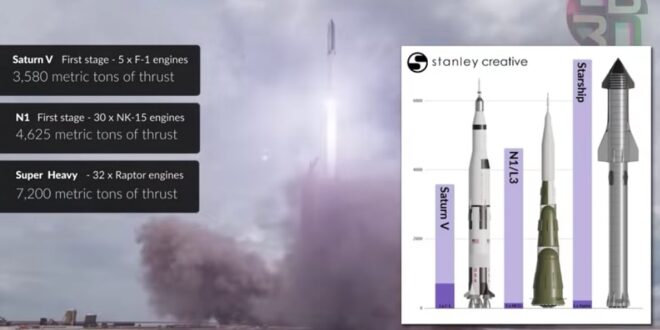In the annals of human history, few endeavors have captured the collective imagination quite like space exploration. From the first tentative steps into the cosmos to the grand visions of interplanetary colonization, our journey into space has been marked by moments of awe-inspiring achievement and technological innovation. At the forefront of this pursuit stand two iconic spacecraft: the Starship and the Saturn V. In this article, we embark on a comparative analysis of these marvels of engineering, exploring their design, capabilities, and the significance of their contributions to humanity’s quest to reach for the stars.
The Saturn V: A Titan of the Space Age
First, let us pay homage to the behemoth that paved the way for human space exploration—the Saturn V. Developed by NASA in the 1960s, the Saturn V remains the tallest, heaviest, and most powerful rocket ever built. Standing at a towering height of 363 feet and weighing in at a staggering 6.2 million pounds at liftoff, the Saturn V was a testament to the ingenuity and determination of the engineers and scientists of its time.
Powered by five F-1 engines in its first stage, the Saturn V possessed a thrust of over 7.5 million pounds, propelling it into orbit with unparalleled force. Its three-stage configuration allowed it to carry payloads of up to 260,000 pounds—a capability that proved instrumental in the success of the Apollo missions, including the historic Apollo 11 moon landing in 1969. Indeed, the Saturn V remains synonymous with humanity’s first steps on another celestial body, symbolizing the pinnacle of achievement in space exploration during the 20th century.
Starship: A New Dawn in Space Travel
Fast forward to the 21st century, and we encounter a new contender in the realm of space exploration—the SpaceX Starship. Conceived by entrepreneur Elon Musk with the ambitious goal of enabling interplanetary travel, the Starship represents a paradigm shift in spacecraft design and technology. Standing at approximately 394 feet tall when fully assembled, the Starship is a towering monolith reminiscent of its Saturn V predecessor.
However, where the Saturn V relied on expendable rocket stages, the Starship embraces a fully reusable architecture. This revolutionary approach aims to drastically reduce the cost of space travel, opening up possibilities for missions to Mars, the Moon, and beyond. Powered by SpaceX’s innovative Raptor engines, the Starship promises unparalleled performance, with a projected payload capacity exceeding that of the Saturn V.
A Comparative Analysis
Now, let us delve deeper into the key differences between these two titans of space exploration. One of the most striking distinctions lies in their propulsion systems. While the Saturn V relied on traditional liquid-fueled rocket engines, the Starship incorporates methane-powered Raptor engines—a choice driven by SpaceX’s commitment to sustainability and the utilization of resources found on other planets, such as Mars.
Additionally, the reusability factor sets the Starship apart from its predecessor. Whereas each Saturn V launch required the construction of a new rocket, the Starship’s ability to return to Earth and be refurbished for subsequent missions represents a monumental leap forward in cost-efficiency and sustainability.
Furthermore, the intended missions of these spacecraft diverge significantly. While the Saturn V was primarily designed for lunar exploration within the confines of NASA’s Apollo program, the Starship aims to enable the colonization of other planets, particularly Mars. SpaceX envisions a future where Starships ferry humans and cargo to Mars, laying the groundwork for a self-sustaining human presence beyond Earth.
Conclusion: Bridging Past and Future
The comparison between the Saturn V and the Starship illustrates the evolution of space exploration from its origins in the 20th century to its potential future in the 21st century and beyond. While the Saturn V stands as a testament to the monumental achievements of the past, the Starship represents a bold vision for the future—a future where humanity ventures forth into the cosmos as a multiplanetary species.
As we gaze upon the night sky, let us not only reflect on the triumphs of the past but also look forward with anticipation to the possibilities that lie ahead. Whether it be the towering inferno of the Saturn V or the sleek silhouette of the Starship, these spacecraft serve as symbols of humanity’s enduring spirit of exploration and our insatiable curiosity about the universe that surrounds us. In the end, it is not merely the hardware that defines our journey into space but the boundless aspirations and dreams that propel us ever onward towards the stars.
 HammBurg Be informed with latest news, reviews, entertainment, lifestyle tips, and much more.
HammBurg Be informed with latest news, reviews, entertainment, lifestyle tips, and much more.




